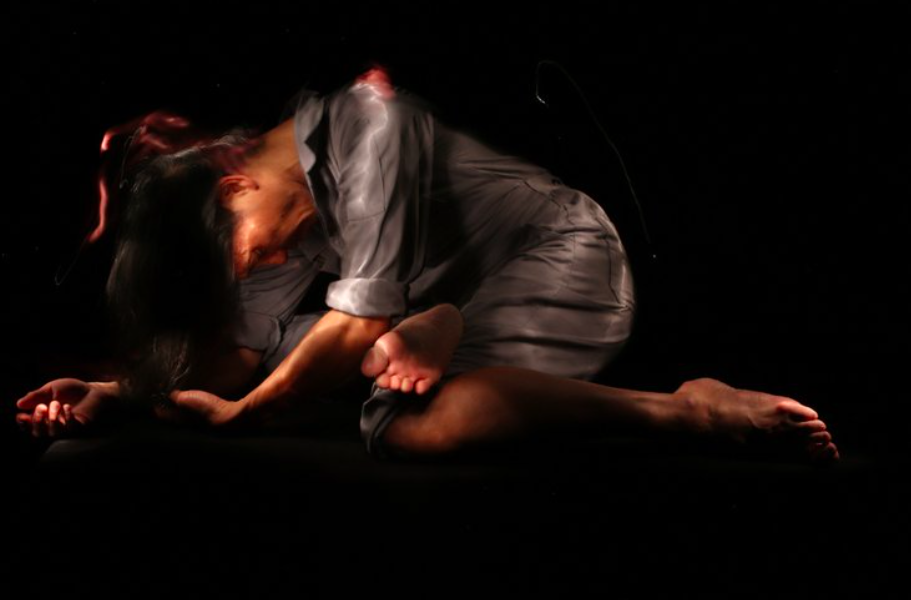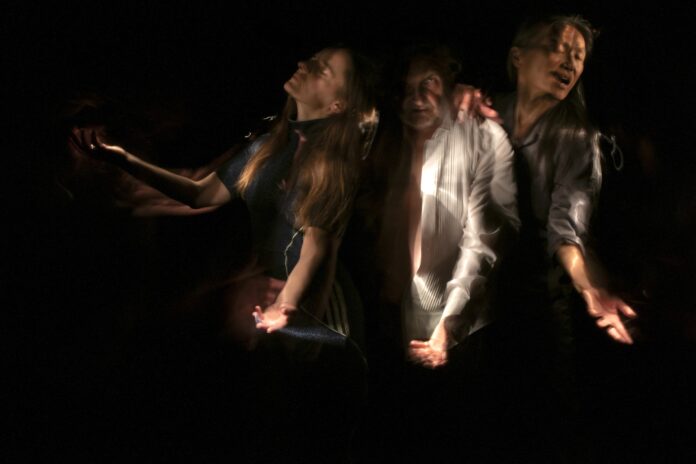First comes the guide to lead you into the space. It’s dark (as advertised) and there are few indicators of where in that space you are. Just a comforting voice telling you how to find a guide rope with your right hand, and the raised, tangible line on the ground that directs your feet along straight lines and corners. Your left hand on the shoulder of the person in front of you reminds you that you are in community. This stranger is a part of it, just as you are, as is the guide who waits until you’re seated safely, then departs to act as wayfarer for another small set of travelers.
As a prelude to Into the Dark (through Sun/19 at Counterpulse, SF)—the newest full-length work from Gravity, “created by an ensemble of Blind, Low Vision, and Sighted physical performers“—this guided walk into the space is a precursor to the performance that follows. Which is a concentrated attempt to shape a piece around the access practices with which it was made, each performer representing a different set of needs and artistic practice for an audience who also represent a spectrum of need and ability. This fact was already demonstrated by my claustrophobic plus-one, who noped out before they could even close the door behind her, spending the duration of the show pacing the lobby, hopefully entertained by the exhibit of photography created by Blind artist Gerald Pirner, also a featured performer in the show.
After we’re seated and expectant, voices emerge from the surrounding darkness to affirm that performers are present and ready. The tapping of a cane begins a slow and steady navigation as my eyes conjure shapes out of shadows and catch the briefest pinpoints of illumination emanating from the bases of stage lights hanging above us. A rustle of leaves surrounds me as invisible branches brush my face. I’d spent the day picking olives in Sebastopol, so it’s no surprise that I immediately think of those supple, silvery trees. In my mind I reached up and collect a handful of fruits, small and smooth. I don’t know what memories my fellow audience members reflect on in the moment, but the indelible presence of those invisible trees stayed with me through the performance.
In any performance, audience members create their own interpretations of the event, no matter how carefully the creative team works to create an experience that adheres to a specific concept. This axiom finds emphasis in Into the Dark, as I—a sighted person—grope for meaning as the performers describe in selective detail where they are in the room, and who they have found themselves next to.

“I feel your body near me,” one voice says to another.
“I feel your hands on my back,” another exclaims.
“I feel my large intestine feeling your ribcage,” groans a voice presumably being pressed to the ground by a comrade.
“I feel like we’re hiding from something,” a refrain begins.
Hiding indeed. As the piece progresses it begins to feel as if what’s missing is a thread of connectivity to imbue each scene with a purpose beyond the access practice it features. This isn’t to say that many of these features do not resonate. Moments in the piece where the cast clap, chant, and stomp in unison feel especially urgent. A harsh, sharp flash of light that ever so briefly reveals the seating configuration. A resurrected song lyric from the turn of this century intoned like a prayer or a spell. The not especially revelatory but nonetheless apt use of cell phones as practical lighting instruments, and voiceovers as a multi-lingual soundtrack.
But something that feels lacking within this curated demonstration of access and artistic practice is a way to invite the audience more definitively into its closed circle. In (in)Visible, an earlier piece by Gravity that played with many of the same concepts, audience members were seated on the stage and the dancers activated the space surrounding them to intimate effect. In Into the Dark the seating arrangement is more or less reversed, and the attendant sensation of straining outward into ambiguous space feels at times alienating, even intrusive of the performer’s shared energy.
I never got the sense that the audience is necessary to the show’s synergy, merely that we are meant to bear some kind of witness, and occasionally lend our bodies as props for the dancers who glide past, or crawl on the ground past our feet. I listened to their hearty laughter emanating from the center of the space, wishing wistfully to be in on the joke.
Of course one could apply similar commentary about a hundred other shows built to a hundred different specificities. If the audience is not the subject, is it the right of an audience to insert itself into the work? Why would I even expect a piece centering Blindness to cater to my personal notions of engagement? Was alienation the point? A notion I continued to interrogate through the weekend, and a doubtlessly timely reminder that any creative work can only exist as itself, not as a summary of the expectations of others.
INTO THE DARK runs through November 19 at CounterPulse. More info here.





